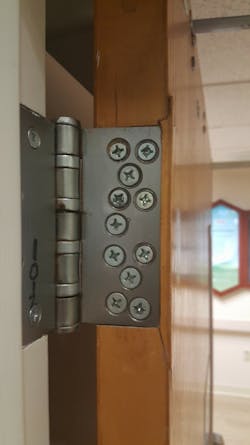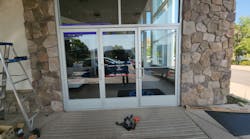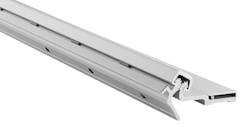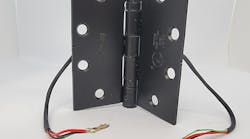Hinges often are overlooked in the door hardware industry, but the quality of the opening hangs literally on the quality of a door’s hinges. I’d argue that with regard to an opening, the hinges are just as important, if not moreso, than the lockset.
No one knows exactly when the hinge was invented. Some archaeologists believe that the hinges showed up in the early Bronze Age when ancient Mesopotamian civilizations were working with metals, but there also is evidence of people using wood and stone for hinge-like devices before then.
Hinges weren’t mass manufactured till the Roman Empire started to develop and work with them. The Romans used hinges to make armor more flexible. They also used hinges for cabinets and drawers and even started to use them on community buildings. Before this, hinges were used solely for temples and strongholds. The Romans even had a goddess of the door hinge, Cardea. I doubt there were any other gods or goddesses of door hardware!
Hinges are all around us, from holding our car door open while we pile in our kids, to holding the refrigerator door open while we stare into it trying to decide what to eat. Think about all the times you walked through a door. Hinges always have been there for you.
Because hinges are often forgotten, they can be the root of many problems you might have with your openings. A hinge failure can contribute to the liability that comes with security risks and potential life-safety code violations.
Let’s “swing” into this article and learn more about five hinge applications you might not be aware of.
No. 1. No Ifs, Ands or Butts
The most common hinge in the commercial industry is the butt hinge. (I know. I said butt. When you’re done giggling, we’ll move on.) A butt hinge is two leaves, typically metal, that interlock with knuckles all held together by a pin. When you remove the pin that holds the leaves together, you can take the door down. This is great if you have to work on a door but not so great when you want to keep that opening secure.
You can have the most secure high-tech quality lock on the door, and it won’t make a difference if you don’t secure that pin. An intruder simply can remove the pin and remove your door. Make sure you specify a nonremovable pin for your secure doors.
No. 2. Continuous Use
For most commercial doors that draw a decent amount of traffic, I recommend having a heavy-duty ball-bearing butt hinge that meets ANSI/BHMA A156.1 Grade 1. These hinges are a well-oiled machine — simple to replace, easy to shim and have been cycle-tested more than 2.5 million times. So when would you want to use a continuous hinge instead of a heavy-duty butt hinge?
There are several advantages a continuous hinge has over a heavy-duty butt hinge:
- To help with door weight and pressure distribution. On standard butt hinges, most of the door’s weight hangs on and pulls on the top hinge. A continuous hinge distributes that weight evenly throughout the frame. As a result, your opening will stay in alignment longer, and the longevity of your opening will increase.
- To help with security. An intruder who encounters a continuous hinge would have to cut through the entire edge of the frame to remove your door. If you used a butt hinge, the intruder simply could cut through a few small hinges to gain access to your facility.
Continuous hinges sound too good to be true, and you might be correct. In a perfect world, I’d install these on most exterior and high-use doors. But the cost can be quite a bit more than for heavy-duty butt hinges, and the install can be fairly tricky compared with a simple butt hinge (and use more screws). Shipment costs also can add up, because most continuous hinges require freight shipping because of the length of the product. However, this is changing with the arrival of modular hinge solutions that allow you to create a continuous hinge from different lengths.
A good balance of both types of hinges is most likely the best solution for your facilities.
No. 3. Shim Shimmery
Most of the door hardware issues I run into are with fire-rated doors. Whether they were missed in the final building inspection or modified or replaced as the building settled, these are life-threatening issues that should be resolved quickly!
Buildings settle into their foundation during the first few years after new construction. What does this mean for your door hardware? When a door frame was installed, it should have been square and plum, but now that the building has settled, the door frame often can become askew. Then, all of a sudden, you’re getting a plethora of work-order requests for doors not latching correctly. Fire doors that don’t latch correctly can spell trouble for your next inspection and, more important, won’t stop smoke and fire from spreading throughout your building.
Most people blame the locking hardware, because that often is where the door binds and doesn’t latch properly. But most of the issues are because the frame is askew. If this troublesome opening is fire-rated, what can you do, replace the frame? Reinstall and reinspect? That sounds — and is — extremely expensive.
Simply, you can shim the hinges to realign the door with the correct clearances to the frame. “But Benji, can you shim hinges on a fire-rated opening?” According to NFPA 80, yes, you can — as long as the shims are made of steel.
I used to shim hinges by using my business cards until I learned about this standard. Business cards were my go-to, because I always had them on me, and you can tear or fold them to create almost any shim you’d like. You still can use your business cards as shims for nonfire-rated openings, but stock up on steel shims for those fire-rated openings that have settled.
When shimming a door, I always look to Steel Door Institute’s shim guide: https://steeldoor.org/sdi-122/
No. 4. Got Door Sag? Try this!
Whether your door is too heavy for its hinge or your door hangs low from too much use or abuse, I’m sorry to say this, but you have door sag. On typical doors, most of the weight and pull is on the top hinge. Often, this is where we find issues relating to door sag. If a door binds at the top and the sag continues to release slowly, there will come a day when your door won’t close without you lifting the door to set it back in its frame. This can be a serious concern for fire safety and security — I’m sure you wanted those doors to close for a reason. If someone isn’t paying attention or doesn’t listen to your door latching or not latching behind you (and all good #Doorks do), this can open the door for trouble.
So how can we prevent door sag? Considering that you can’t change gravity, I have three solutions:
- Before the door is installed. For new construction or new doors being installed, make sure the doors are specified with the correct weight limits per number of hinges per your manufacturer’s recommendations. If there are concerns for particularly heavy or high-traffic doors that take a lot of rebuttals, try specifying or recommending an anchor hinge or even a continuous hinge. The anchor hinge will help to spread the weight throughout the top of the frame, and the continuous hinge will help to spread the weight throughout the side of the frame. That’s instead of having most of the weight and rebuttal on that poor, overworked top hinge.
- Preventative maintenance. I know it’s difficult to find time for preventative maintenance, but making notes of doors that have early signs of door sag can save you the time and hassle of being called out at midnight to fix a door that isn’t closing. If you already are working on a door or happen to be walking through one, keep your eye out for tighter-than-normal clearances, particularly at the top of the latching side and the bottom corner of your door. Take a glance at the top hinge. Do the screws look loose? These are early signs of door sag.
- Lift, align and reinforce. You’ve done all you can to specify and prevent, but you still have door sag. Here’s what I’d recommend: First, lift the door by using a few wedges or an inflatable wedge to let that door release all that weight. Then, align the door in the frame with the correct clearances. Last, after the door is aligned properly, you can screw in a high-frequency reinforcing pivot. These reinforcing pivots might not be the most attractive piece of hardware, but they sure hold their weight, and it certainly beats reinstalling the door and frame.
No. 5. Invisible Hinges
If you haven’t seen or used concealed hinges, sometimes referred to as invisible hinges, you will. They’re becoming more popular and for good reason. Most architects despise dealing with doors, because, often times, our codes and standards get in the way of their aesthetics or designs. Architects love concealed hinges, primarily because they don’t have to look at them. #Doorks should love them as well, because the hinges are easy to adjust and extremely durable if you get the correct ones, and you don’t have to worry about people messing with your hinges. Also, let’s be honest: We like a good-looking door, too!
To hinge or not to hinge? That isn’t actually a question, because we all have to have hinges to hang our doors. Hopefully this article gave you more insight into a handful of applications you can use. From making your hinges more secure, reliable and attractive to preventing binding and door sag, hinges are one of the most important components of your door.
Benji Bolick, The Door Dork, is senior digital communications specialist at ASSA ABLOY Opening Solutions and is “obsessed” with doors and hardware. Check out more of his content and join the Door Dork community on LinkedIn: Benji Bolick the Door Dork #doordork






